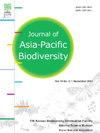基于保守基序分析的山羊虱子分子鉴定
IF 0.7
Q4 BIODIVERSITY CONSERVATION
引用次数: 0
摘要
羊虱(anoplae:羊虱科)是蚤病的重要体外寄生虫。然而,由于GenBank中缺乏分子数据,它们的分子分类和鉴定仍然具有挑战性。摘要本研究旨在建立一种分子鉴别方法,对在玉林捕获的羊虱进行鉴定,鉴定为非洲羊虱(Linognathus africanus)。从GenBank中下载了天象的序列,保守基序分析表明,核糖体DNA (rDNA) 18S V4、线粒体DNA (mtDNA) 12S和16S是适合通用引物设计的候选基因片段,因为它们序列丰富,基序保守且突变少。这3个基因片段成功扩增并测序,其差异度分别为0.1 ~ 1.7%、0 ~ 0.6%和0.3 ~ 1.3%,表明虱属同一种。BLAST分析显示,18S序列仅与Linognathus同源,12S和16S序列与巴基斯坦L. africanus的同源性分别为98.8 ~ 99.4%和98.7 ~ 99.3%。因此,该虱子标本在分子上被鉴定为非洲虱子,没有地理隔离。结论羊虱属非洲羊虱属。12S和16S是天牛属潜在的DNA条形码。本文章由计算机程序翻译,如有差异,请以英文原文为准。
Molecular identification of goat lice (Anoplura: Linognathidae) based on conserved motif analysis
Goat lice (Anoplura: Linognathidae) are important ectoparasites in pediculosis. However, their molecular classification and identification remain challenging owing to a lack of molecular data in GenBank. This study aimed to establish a molecular method for identifying Anoplura spp. Goat lice were captured in Yulin, China, and morphologically identified as Linognathus africanus (L. africanus). Sequences from across Anoplura were downloaded from GenBank and conserved motif analysis showed that ribosomal DNA (rDNA) 18S V4, mitochondrial DNA (mtDNA) 12S, and 16S were candidate gene fragments suitable for universal primer design because of abundant sequences and long conserved motifs with few mutations. These three gene fragments of the lice specimens were successfully amplified and sequenced, and their divergences were 0.1–1.7%, 0–0.6%, and 0.3–1.3%, respectively, indicating that the lice specimens belonged to the same species. BLAST analysis showed that the 18S sequences were only aligned with Linognathus, while the 12S and 16S sequences showed 98.8–99.4% and 98.7–99.3% similarities, respectively, with those of L. africanus from Pakistan. Therefore, the lice specimens were molecularly identified as L. africanus without geographical isolation. In conclusion, the goat lice specimens were identified to L. africanus. 12S and 16S are potential DNA barcodes of Anoplura spp.
求助全文
通过发布文献求助,成功后即可免费获取论文全文。
去求助
来源期刊

Journal of Asia-Pacific Biodiversity
Agricultural and Biological Sciences-Insect Science
CiteScore
1.70
自引率
12.50%
发文量
94
审稿时长
27 days
期刊介绍:
The Journal of Asia-Pacific Biodiversity (previous title was Journal of Korean Nature) is an official journal of National Science Museum of Korea (NSMK) and Korea National Arboretum (KNA). The scope of journal is wide and multidisciplinary that publishes original research papers, review articles, as well as conceptual, technical and methodological papers on all aspects of biological diversity-its description, analysis and conservation, and its application by humankind. This wide and multidisciplinary journal aims to provide both scientists and practitioners in conservation theory, policy and management with comprehensive and applicable information. However, papers should not be submitted that deal with microorganisms, except in invited paper. Articles that are focused on the social and economical aspects of biodiversity will be normally not accepted.
 求助内容:
求助内容: 应助结果提醒方式:
应助结果提醒方式:


